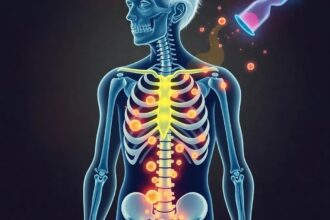Cutting-edge research explores how GI hormones like ghrelin, leptin, and GLP-1 reshape hunger and fullness. Discover their clinical potential and the promise of personalized obesity therapies.
Gastrointestinal hormones hold untapped power in regulating hunger. Discover their hidden role and how they inspire novel obesity treatments in modern medicine.
Understanding Gastrointestinal Hormones
The human body orchestrates hunger and fullness through a network of interlinked mechanisms. Foremost among these are gastrointestinal (GI) hormones, an increasingly studied set of chemical messengers that shape how we perceive the need for food. These hormones include ghrelin, leptin, peptide YY (PYY), cholecystokinin (CCK), and glucagon-like peptide-1 (GLP-1). Each interacts with the brain to influence meal initiation, satiety, and long-term energy regulation. Classical research outlined in Classical works like those published in The Journal of Clinical Endocrinology & Metabolism provided the first substantive evidence connecting GI hormones to the endocrine system. This spurred decades of research focusing on how these hormones modulate hunger and fullness.
By measuring hormone levels in various nutritional states, scientists discovered how the blood’s biochemical signals triggered or halted feeding behaviors.
Modern technology, including gene sequencing and functional imaging of the brain, has propelled our understanding beyond conventional bounds. Scientists now know that ghrelin, secreted primarily by the stomach, peaks when someone experiences hunger. Conversely, leptin is secreted by fat cells, rising when the body has abundant energy stores. These basic patterns might appear straightforward, yet the interplay is complex: disruptions in leptin signaling can lead to constant feelings of hunger even if the body holds surplus fuel. Another player, PYY, originates in the small intestine and targets receptors in the hypothalamus to quell appetite promptly after a meal. Meanwhile, CCK is equally essential for tamping down hunger, often kicking in within minutes of food entering the digestive tract.
A surge of interest has been devoted to GLP-1, as it exerts dual impacts on metabolism and glycemic control. This hormone mediates insulin release from the pancreas in response to elevated glucose, tying closely into managing type 2 diabetes. Developers of novel therapies have looked extensively at GLP-1 to harness its appetite-reducing qualities. GLP-1 receptor agonists have become one of the most discussed treatments among endocrinologists aiming to assist patients with obesity or metabolic syndrome. While these treatments show promise, they are not magic bullets. They must be supported by a thorough lifestyle overhaul: balanced eating, mindful activity, and psychological support when needed.
Historically, the GI tract has played second fiddle to the brain, which many considered the main seat of appetite regulation. Early 20th-century observations regarding hormones like secretin established the notion that the gut even had endocrine properties. Over subsequent decades, appetite regulation emerged as a core interest in endocrinology and metabolism. Shifting public health landscapes, combined with a global obesity crisis, compelled researchers to look at the fundamental biological processes that make some individuals chronically hungry and others satisfied with minimal effort. To do this, scientists created new lab methods to measure hormone levels, encouraging the development of targeted interventions.
In addition to mapping hormones themselves, robust discussion has centered on understanding the precise neural pathways that link GI hormones and the brain’s feeding circuits. For instance, ghrelin directly communicates with the arcuate nucleus in the hypothalamus, sparking neurons that drive food-seeking behavior. Leptin, in contrast, signals the brain that the body’s fat reserves are sufficient. When leptin levels rise, appetite is suppressed, and energy expenditure may be upregulated. This highly coordinated system can go awry if the continuous presence of certain hormones reduces receptor sensitivity. Persistent elevation of ghrelin, for instance, is often associated with constant cravings, ultimately leading to excessive caloric intake. This interplay of endocrine feedback loops and neurotransmitter releases is extensive, implicating other systems like stress hormone release and even circadian rhythm regulation.
Improved knowledge of gene expression and epigenetic factors further enriches the tapestry of GI hormone research. Environmental stimuli, such as dietary patterns and exercise habits, can switch genes on or off, modulating the production of hormones governing hunger. A person might have a genetic predisposition toward higher ghrelin levels, but a balanced high-protein diet plus regular physical activity might offset such a predisposition by reconfiguring the epigenetic signals that control hormone secretion. Several of these findings appear in Nature Reviews Endocrinology, highlighting the intricate link between gene expression, environment, and appetite.
Clinical Implications and Emerging Treatments
The growing obesity epidemic and ballooning rates of metabolic syndrome provide a stark backdrop for the urgent need to refine appetite-related interventions. Pharmacological agents targeting GI hormones rank among the leading developments in this arena. By either blocking or stimulating specific hormone receptors, these drugs can facilitate weight loss and improve metabolic outcomes. GLP-1 receptor agonists exemplify this approach. Current clinical trials continue to confirm their effectiveness in promoting sustained weight reduction and better blood glucose control. Some experts regard these treatments as a cornerstone in obesity care. However, it is crucial to remember that these agents typically complement rather than replace long-standing recommendations for dietary changes, mental health support, and increased physical activity.
Another medical intervention with sweeping implications for appetite regulation is bariatric surgery. Gastric bypass and sleeve gastrectomy procedures reconfigure the intestinal anatomy, not just reducing meal volume, but also altering the hormone secretion patterns in the gut. Many individuals report a diminished appetite post-surgery, stemming from these metabolic shifts. Researchers point to the reduced secretion of ghrelin, among other factors, as one explanation for prolonged post-bariatric weight loss. Recent press releases from leading medical centers emphasize that these procedures are not merely mechanical restrictions; they also provoke metabolic changes that reroute how the body handles hunger and satiety signals.
The emerging field of dual incretin agonists captivates many scientists aiming to amplify GLP-1-based therapies. These compounds stimulate both GLP-1 and glucose-dependent insulinotropic polypeptide (GIP) pathways. Preliminary results indicate that such dual action may offer better weight management and glycemic control than a single-hormone approach. As basic research uncovers more about the osmotic interplay of various hormones, new combination therapies could prove even more potent. Experts caution that safety, efficacy, and long-term adherence must be carefully evaluated, but enthusiasm remains high that these multi-pronged drugs might address some of the more stubborn challenges of obesity.
Beyond pharmaceuticals and surgery, the gut microbiome emerges as a pivotal influencer of hormone activity. Gut bacteria produce metabolites like short-chain fatty acids that can alter the release or function of GI hormones. Dietary patterns that encourage a healthy microbiota – for instance, high in fiber and diverse in plant-based foods – may indirectly regulate appetite by optimizing microbial communities. This evolving science suggests that diet recommendations might soon revolve around fostering beneficial gut flora in addition to standard strategies of calorie control.
Lifestyle interventions targeting stress, mood, and sleep also appear vital. Chronic stress spikes cortisol, which tends to amplify ghrelin levels and boost cravings. Meanwhile, failing to get adequate rest can disrupt leptin and ghrelin, making individuals more vulnerable to late-night eating or constant snacking. Mind-body practices like yoga and meditation are recommended by some clinicians to manage stress, contending that these approaches indirectly stabilize hormone fluctuations.
Critically, gene editing through CRISPR-based technology has, in theory, the potential to correct congenital hormone imbalances. While still in early stages, researchers speculate on how gene editing might fix misregulated leptin or ghrelin genes, creating an environment less prone to obesity. The ethical ramifications, though significant, do not diminish the immense therapeutic potential. Safety concerns and moral considerations will likely keep such interventions in a research phase for years. Enthusiasts in the scientific community point to these breakthroughs as a possible next great leap in metabolic medicine, though caution is warranted.
Many aspects of GI hormone-based therapy highlight a recurring theme: no single solution alone works for every patient. Individuals vary in hormone profiles, genetic makeup, and lifestyles. Personalized approaches strive to offer better outcomes by mapping each patient’s unique hormone signatures before crafting diets, exercise plans, and pharmaceutical strategies. Such individualized care resonates with the push toward precision medicine, wherein an integrated medical team captures these nuances, thereby helping patients set realistic goals.
Practical Recommendations and Future Outlook
Healthcare professionals find themselves on the frontline of harnessing GI hormone insights to combat rising obesity and type 2 diabetes rates. For instance, consistent screening of ghrelin, leptin, and possibly GLP-1 levels can direct clinicians to tailor dietary plans more effectively. A patient with chronically high ghrelin levels might benefit from additional moderate-protein snacks to reduce crashes. In contrast, someone with impaired leptin signaling might need more structured meals and possible medical interventions like appetite suppressants or GLP-1 receptor agonists. Programs that integrate dietitians, mental health specialists, and endocrinologists tend to show improved long-term compliance, as they address the multiple dimensions of food intake.
Patient education remains crucial. Encouraging individuals to employ mindful eating techniques – paying close attention to satiety cues and emotional triggers – can be especially powerful. Many remain unaware that an early sense of fullness often signals that enough nutrients have been consumed, yet ignore it due to habits, stress, or social influences. Professionals looking to enhance patient compliance can reinforce the importance of tracking hunger levels on a simple numeric scale, distinguishing physical hunger from emotional cravings. This conscious awareness may be especially valuable for those with hormone imbalances, where a body in chronic imbalance may send confusing signals.
For the immediate future, new drug categories, including dual incretin agonists, hold significant promise in bridging the gap where lifestyle changes alone fall short. Obesity is recognized by many medical associations as a chronic disease with multifactorial causes, requiring the same rigorous, long-term management as any other chronic condition. Regulatory bodies across the globe continue to evaluate these medications, balancing their efficacy against the possibility of side effects such as gastrointestinal discomfort. There is optimism that further refinements in dosing and compound design will mitigate these limitations and enhance patient quality of life.
Longer term, integrative approaches that blend functional medicine, robust lifestyle strategies, and advanced interventions might shift the landscape of obesity management. Researchers are keen to explore how advanced biomarker testing can fine-tune diets. If a patient’s hormone profile indicates a mild leptin deficiency, a carefully timed balance of protein, fiber, and healthy fats might optimize satiety without the need for medication. Pairing this tactic with adequate sleep, stress management, and targeted exercise often yields shifts in metabolism that support sustainable weight control.
Ethical considerations also come into sharper relief as scientific capacity advances. For instance, the ability to manipulate the gut microbiota via selective bacterial transplants introduces questions about equitable access and potential unknown consequences of drastically altering an individual’s ecosystem. Similarly, gene editing to regulate hormone production challenges broader public acceptance. Past experiences in genetic modification suggest that while the technology can deliver stunning benefits, societal support depends on transparent research, proven safety, and meticulous oversight. Nonetheless, in the face of surging obesity rates, many experts feel we cannot overlook the promise of innovative treatments.
Healthcare professionals often advocate comprehensive, team-based care to tackle these multifaceted demands. A patient could underperform with medication alone if the underlying triggers for overeating, such as stress or emotional patterns, remain unresolved. Equally, those who practice impeccable nutrition might still struggle if their hormone regulation is fundamentally off. That is where an endocrinologist’s ability to interpret hormone levels merges with a psychologist’s capacity to manage behavioral triggers, reinforcing the notion that we cannot isolate any single factor when approaching weight loss.
While pharmaceutical research commands headlines, the power of lifestyle intervention remains unequivocal. A moderate exercise routine, focusing on activities an individual finds enjoyable, not only reduces stress but can also favorably shift levels of hormones like ghrelin and PYY. In addition, a nutrient-rich diet emphasizing whole foods and balanced macronutrients counters inflammation, which some studies link to hormonal imbalances. According to Obesity Reviews, mindful eating techniques and the adoption of scientifically backed dietary patterns (e.g., Mediterranean-style or plant-forward) are connected with more stable leptin, ghrelin, and insulin levels.
Apart from that, acknowledging coexisting factors such as mental health conditions or inherited predispositions is vital. The interplay between cortisol and GI hormones underscores why stress management exercises, therapy sessions, or community support groups can indirectly facilitate better metabolic outcomes. The road to stable weight and metabolic health often requires these comprehensive measures. In the near future, portable devices that consistently monitor hormone levels might integrate with smartphone apps, delivering real-time feedback on hunger signals. These possibilities herald a new era in personalized medicine, where patients glean immediate insights into whether their appetite stems from low blood glucose, psychological distress, or a genuine biological need for more nutrients.
Combining optimism and caution is prudent. The complexities of GI hormones suggest that breakthroughs occasionally lead to partial or short-lived success unless consistently managed. Early laparoscopic procedures taught the medical community that physically decreasing stomach size may trigger new hormonal responses. Similarly, prescribing appetite-reducing medications can lighten the hunger burden, but if underlying behavioral or genetic components remain unaddressed, weight can return. As new therapies progress from clinical trials to commonplace practice, a deeper understanding of the gut-brain interface will be essential.
Looking ahead, integrative pursuits could stretch beyond conventional boundaries, spotlighting discipline-blurring studies. Food science, neuroscience, endocrinology, and even fields like public health policy must converge to foster sustainable solutions. The next wave of research may include analyzing how the physical environment, available food choices, and socioeconomic factors interact with hormone-driven hunger. Preventive measures that teach children healthy eating habits and coping strategies for stress could shape hormone regulation patterns throughout the lifespan, potentially reducing obesity rates across entire communities.
Multiple publications, including The New England Journal of Medicine and Nature Reviews Endocrinology, continue to release data that refine the public’s perspective on appetite regulation. These journals highlight real-world outcomes of new therapies, elaborate on the safety of extended hormone-based regimens, and spark debate on how to implement findings ethically. Sustained weight-loss success hinges on bridging sophisticated molecular science with practical everyday strategies. From a purely biological standpoint, tampering with hunger hormones might appear straightforward, but translating these insights into durable healthcare strategies can be extraordinarily complex. Individual differences in hormone secretions, the realities of daily life, and the psychological underpinnings of eating all intersect in ways that defy superficial fixes.
In conclusion, gastrointestinal hormones encapsulate a sophisticated network of signals that bridge the gut, brain, and energy reserves. Their importance in appetite regulation cannot be overstated. As healthcare practitioners broaden their grasp of ghrelin, leptin, PYY, CCK, and GLP-1, the horizon for obesity management and metabolic health widens. Each hormone has a distinct role and a unique method of communicating with neural pathways. Supporting healthy hormone function means integrating pharmaceutical options, nutritional interventions, and lifestyle modifications. Ongoing research consistently reveals deeper complexities, particularly around epigenetics and the microbiome, opening new frontiers in science. Meeting these challenges demands a symphony of expertise – from endocrinologists to behavioral counselors – all working to ensure patients achieve sustainable progress. With the promised advent of more refined and less invasive therapies, the future holds transformative potential in appetite regulation, ultimately creating more accessible and effective ways to prevent and address obesity.




